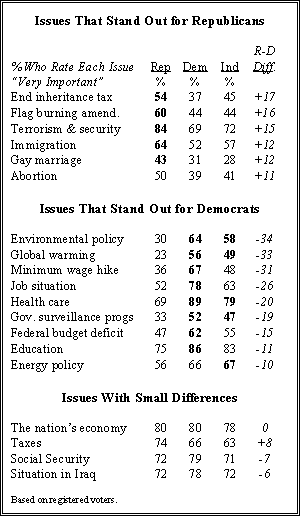Rediscovering Liberalism in What's Really Important

Democrat Top Three
1. Health Care
2. Education
3. Economy
Democrat Bottom Three
1. Gay marriage
2. Ending inheritance tax
3. Abortion
--------------
Republican Top Three
1. Terrorism
2. Economy
3. Education
Republican Bottom Three
1. Global warming
2. Environment
3. Government surveillance programs
---------------
Independent Top Three
1. Education
2. Health Care
3. Economy
Independent Bottom Three
1. Gay marriage
2. Abortion
3. Flag burning amendment
With the exception of terrorism, the other issues of high importance to voters this fall are hardly getting any meaningful coverage in the media and mainstream public discourse.
Conversely, lots of talk time is going to issues like flag burning, gay marriage, and ending the inheritance tax, which appear on the bottom of the importance list for most voters.
Part of this can be explained by the fact that Republicans control the federal government and merely raising issues in the form of constitutional amendments or legislative bills can set off a media firestorm on them. It's an all-out effort aimed at distraction in an election year where approval numbers for the top Republican in the country are at horribly low levels and the public is becoming increasingly aware of what little has been done on the domestic front to help the middle and lower classes over the past six years.
But it can't all be blamed on the GOP. After all, Dems have been doing backflips trying to find a position on Iraq that appeals to both each other and the public at large. Granted, formulating a position is necessary, but in doing so they have essentially handed the terms of the election year debate over to Republicans (in essence, the issue over Iraq is simple: Dems are for change, Repubs are for more of the same).
As long as the Dems are simply reacting to news rather than creating it they will continue to have no meaningful agenda.
And while it's tough to step out of the wave of pointless legislation coming out of the GOP distraction machine recently, the sooner the Dems start tackling the issues that are actually important to voters -- health care, education, and the economy -- the sooner they will be able to re-discover what liberalism is all about.


